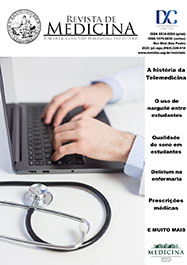Ictiose arlequim – manejo do nascimento aos 3 anos de idade
DOI:
https://doi.org/10.11606/issn.1679-9836.v99i4p411-414Palavras-chave:
Ictiose lamelar, Anormalidades congênitas, Dermatologia, PediatriaResumo
A ictiose arlequim possui uma prevalência de 1/100.000 nascimentos e é frequente o óbito ocorrer no período neonatal. Objetivo: descrever um caso em que o tratamento adequado permitiu a sobrevida da paciente. Descrição do caso: Recém-nascido (RN) do sexo feminino com 2665g, nasceu com placas hiperceratósicas e fissuras difusas pelo corpo, ectrópio bilateral com oclusão palpebral, eclábio e pés e mãos fletidos características de Ictiose congênita do tipo arlequim. O acitretin foi iniciado aos 7 dias de vida associado ao tratamento suportivo, evitando o óbito neonatal. Comentários: Atribui-se a sobrevida da paciente à intervenção com acitretin oral precoce e os cuidados intensivos neonatais.
Downloads
Referências
Oji V, Tadini G, Akiyama M, Bardon CB, Bodemer C, Bourrat, E, et al. Revised nomenclature and classification of inherited ichthyoses: results of the First Ichthyosis Consensus Conference in Soreze 2009. J Am Acad Dermatol. 2010; 63:607-41. doi: https://doi.org/10.1016/j.jaad.2009.11.020.
Schmuth M, Gruber R, Elias PM, Williams ML. Ichthyosis update: towards a function-driven model of pathogenesis of the disorders of cornification and the role of corneocyte proteins in these disorders. Adv Dermatolol. 2007;23:231-56. doi: https://doi.org/10.1016/j.yadr.2007.07.011.
Kelsell PD, Norgett EE, Unsworth H, Teh MT, Cullup T, Mein CA, et al. Mutations in ABCA12 underlie the severe congenital skin disease harlequin ichthyosis. Am J Human Genet. 2005;76(5):794-803. doi: https://doi.org/10.1086/429844.
Harvey HB, Shaw MG, Morrell DS. Perinatal management of harlequin ichthyosis: a case report and literature review. J Perinatol. 2010;30(1):66. doi: https://doi.org/10.1038/jp.2009.100.
Lai-Cheong JE, McGrath JA. Advances in understanding the genetic basis of inherited single gene skin barrier disorders: New clues to key genes that may be involved in the pathogenesis of atopic dermatitis. An Bras Dermatol. 2006;81(6):567-71. https://doi.org/10.1590/S0365-05962006000600009.
Rajpopat S, Moss C, Mellerio J, Vahlquist A, Gånemo A, Hellstrom-Pigg M, Kennedy C. Harlequin ichthyosis: a review of clinical and molecular findings in 45 cases. Arch Dermatol. 2011;147(6):681-6. doi: https://doi.org/10.1001/archdermatol.2011.9.
Rathore S, David LS, Beck MM, Bindra MS, Arunachal G. Harlequin ichthyosis: prenatal diagnosis of a rare yet severe genetic dermatosis. J Clin Diagn Res. 2015:9(11):QD04. doi: https://doi.org/10.7860/JCDR/2015/15250.6705.
DiGiovanna JJ, Mauro T, Milstone LM, Schmuth M, Toro JR. Systemic retinoids in the management of ichthyoses and related skin types. Dermatol Ther. 2013;26(1):26-38. doi: https://doi.org/10.1111/j.1529-8019.2012.01527.x.
Gulasi S. Congenital ichthyosis: a case treated successfully with acitretin. Iran J Pediatr. 2016;26(5). doi: https://doi.org/10.5812/ijp.2442.
Yanagi T, Akiyama M, Sakai K, Nagasaki A, Ozawa N, Kosaki R, et al. DNA-based prenatal exclusion of harlequin ichthyosis. J Am Acad Dermatol. 2008;58(4):653-56. doi: https://doi.org/10.1016/j.jaad.2007.12.018.
Ahmed H, O’toole EA. Recent advances in the genetics and management of harlequin ichthyosis. Pediatr Dermatol. 2014;31(5):539-46. doi: https://doi.org/10.1111/pde.12383.
Koochek A, Choate KA, Milstone LM. Harlequin ichthyosis: neonatal management and identification of a new ABCA12 mutation. Pediatric Dermatol. 2014;31(2):e63-e64. doi: https://doi.org/10.1111/pde.12263.
Edwards WH, Conner JM, Soll RF, Vermont Oxford Network Neonatal Skin Care Study Group. The effect of prophylactic ointment therapy on nosocomial sepsis rates and skin integrity in infants with birth weights of 501 to 1000g. Pediatrics. 2004;113(5):1195-203. doi: https://doi.org/10.1542/peds.113.5.1195.
Czarnowicki T, Malajian D, Khattri S, da Rosa JC, Dutt R, Finney R, et al. Petrolatum: barrier repair and antimicrobial responses underlying this “inert” moisturizer. J Allergy Clin Immunol. 2016;137(4):1091-102. doi: https://doi.org/10.1016/j.jaci.2015.08.013.
Glick JB, Craiglow BG, Choate KA, Kato H, Fleming RE, Siegfried E, Glick SA. Improved management of harlequin ichthyosis with advances in neonatal intensive care. Pediatrics. 2017;139(1):e20161003. doi: https://doi.org/10.1542/peds.2016-1003.
Tontchev G, Silverberg NB, Shlasko E, Henry C, Roberts JL, Roth MZ. Techniques for toddlers: linear band incision for harlequin ichthyosis with associated compartment syndrome. Pediatr Dermatol. 2014;31(5):625-9. doi: https://doi.org/10.1111/pde.12446.
Lefèvre C, Audebert S, Jobard F, Bouadjar B, Lakhdar H, Boughdene-Stambouli O, et al. Mutations in the transporter ABCA12 are associated with lamellar ichthyosis type 2. Hum Mol Genet. 2003;12(18):2369-78. doi: https://doi.org/10.1093/hmg/ddg235.
Sakai K, Akiyama M, Yanagi T, et al. ABCA12 is a major causative gene for non-bullous congenital ichthyosiform erythroderma. J Invest Dermatol. 2009;129:2306-9. doi: https://doi.org/10.1038/jid.2009.23.




